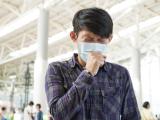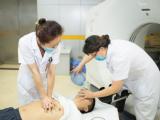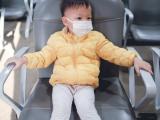May 19, 2003 (CIDRAP News) – In a study of 75 SARS (severe acute respiratory syndrome) patients from the Amoy Gardens outbreak in Hong Kong, most patients improved after a few days of hospitalization but then worsened in their second week of illness, possibly because of an overly intense immune response to the virus.
Citing evidence that the amount of virus in the patients' bodies was declining by the 10th day of illness, the authors suggest that the patients' deterioration in the second week may have been due to their immune response, not the virus itself. Their report was published online in The Lancet.
Most of the patients improved after the second week of illness, but 15 experienced acute respiratory distress syndrome (ARDS) and needed ventilatory support. "The progression of the disease to respiratory failure might not be associated with uncontrolled viral replication, but may, in fact be immunopathological in nature," write J. S. M. Peiris and colleagues from Queen Mary Hospital at the University of Hong Kong.
The investigators prospectively studied the first 75 adult SARS patients from the Amoy Gardens housing complex, tracing their clinical, radiological, and virological changes for 24 days. The patients, who were among 321 Amoy Gardens residents who contracted SARS, all were treated in the same hospital. All met the World Health Organization's (WHO's) SARS case criteria, including fever (38 C or higher), cough or shortness of breath, and new pulmonary infiltrates on chest x-rays or CT scan. The patients all were treated with a standard regimen of ribavirin and corticosteroids.
Fever resolved in all but one patient within 48 hours after hospital admission, and myalgia and other systemic symptoms also improved after a few days, according to the report. However, fever returned in 64 (85%) patients an average of 8.9 days after illness onset, the report says. In addition, 55 patients (73%) had watery diarrhea starting an average of 7.5 days into the illness, and radiographic signs worsened for 60 (80%) patients at a mean of 7.4 days.
Twenty-four (32%) patients had to be placed in intensive care after an average of 11.0 days, and 19 of these experienced acute respiratory distress and required ventilatory support by 12.9 days. Multivariate analysis showed that older age and chronic hepatitis B virus infection were independent risk factors for the development of ARDS. Five patients died during the study period, two of them because of myocardial infarctions.
The SARS-associated coronavirus was identified by reverse-transcriptase polymerase chain reaction (RT-PCR) analysis of nasophyaryngeal fluids in 24 (32%) patients at initial presentation; this proportion increased to 51 (68%) patients by day 14. In 14 patients, a series of quantitative RT-PCR analyses of nasopharyngeal samples showed that the viral load peaked on day 10 and then declined. RT-PCR analysis of urine and fecal samples also showed declining viral shedding from days 10 to 21 after illness onset. Testing of blood serum samples detected SARS coronavirus immunoglobulin G in 70 (93%) patients at an average of 20 days.
In view of the virologic findings, the authors say that the clinical deterioration and worsening pulmonary lesions that occurred starting about 10 days into the illness can't be blamed on the virus itself. "These findings suggest that the lung damage at this phase is related to immunopathological damage as a result of an overexuberant host response, rather than uncontrolled viral replication," they write.
The WHO said public health workers and clinicians should be aware of the three-stage clinical course revealed in the study. "In terms of preventing further spread, including nosocomial transmission, it is dangerous to prematurely relax precautions, notably isolation and infection control, following clinical improvement during the first week of illness," the agency said in a May 16 statement.
Peiris JSM, Chu CM, Cheng VCC, et al. Clinical progression and viral load in a community outbreak of coronavirus-associated SARS pneumonia: a prospective study. Lancet 2003; early electronic release [Full text]




















